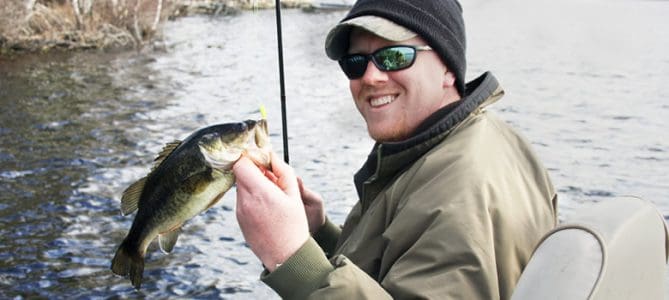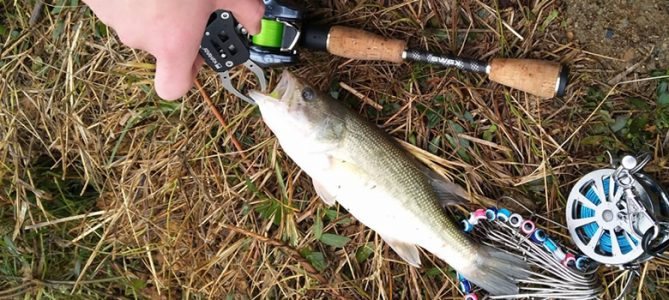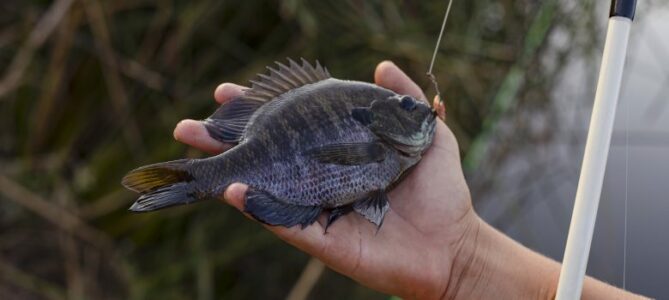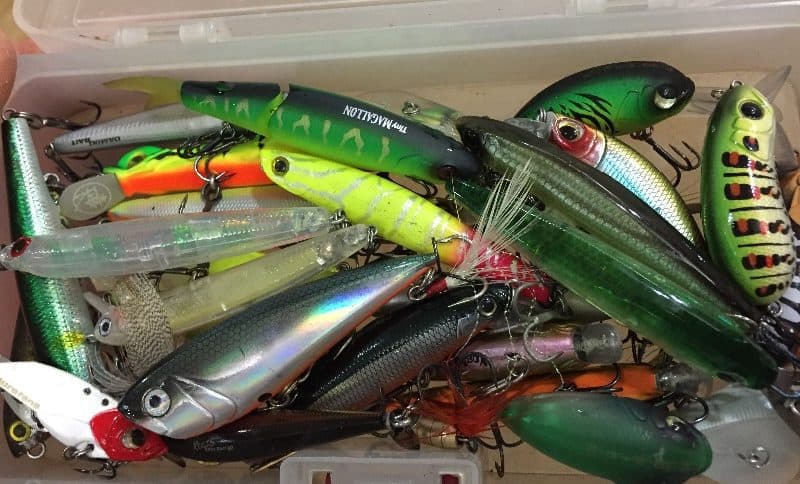If you buy via a link on this page, we may receive a commission, at no extra cost to you.Learn more
Behind bass, trout is the fish that anglers target the most. They are abundant, put up a decent fight, and are very tasty. Additionally, you can target them with a variety of lures and techniques. Which technique works best depends on several variables such as water temperature, watercolor, and time of day.
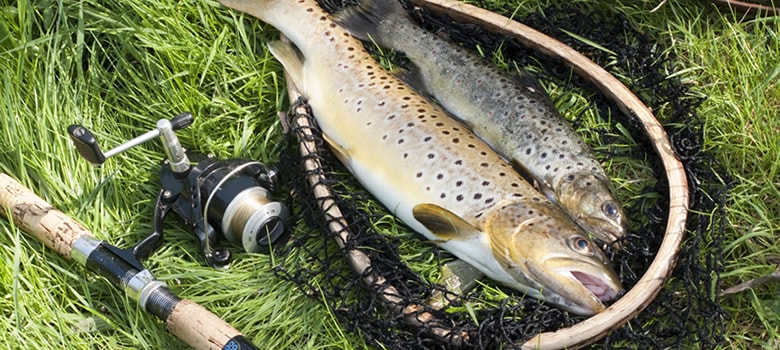
The water body itself plays a crucial role as well. Fishing for trout in a lake is completely different from fishing for trout in a river. And that’s the beauty of trout fishing. You are constantly switching tactics for a chance of lading one. But don’t worry. We’ve taken the time to share some of our expertise in the area.
Here you will find lots of useful information like how to fish for trout, what is the best water temperature for trout fishing, what is the best lure for trout, and much more!
Lake Trout Fishing
Trout are active species. They are constantly moving from one place to another when they find themselves in a lake. However, like all animals, they follow a pattern. Things get easier once you discover it.
The most important thing that you must know about trout is that they love cold water. In addition, trouts often seek the protection of weeds and other underwater structures. Targeting these areas proves effective during colder months.
The in and out streams are also productive, especially during spring and fall. However, some lakes don’t have them. If this is the case, work your lure within the shoreline.
In contrast, a fish finder will help you to locate trout during summer. As the water temperature rises, they flee to the depths. Deep diving lures and similar tactics prove to be the most effective.
Trout Fishing Techniques for Lakes
You can use many different approaches while fishing for trout in the local lake. How effective each one is depends on the environment. Here you have three techniques:
- Deep Fishing: When the summer quicks in, it means that trouts are deep. Hence, getting the lure near the bottom the key to success.
However, trouts aren’t bottom feeders. Therefore, the lure has to swim above it to tempt them. Attaching a sinker 1 or 2 feet above the bait or lure will give it the freedom to swim. In addition, adding the weight will increase your casting distance, enabling you to cover more area.
- Suspending Bait: During colder months, trout are higher in the water column. Hence, suspending the bait or lure will increase your chances of getting bites.
Hook, bait, weight, and a bobber are the only pieces of gear you need. Attach the bobber between 1 and 3 feet above the tag. Then, thread the weight and hook at the end. The sinker will help you bait to sink while the bobber keeps the entire section floating.
- Retrieving: This technique applies to spinnerbaits, spoons, flies, and similar lures. These lures work like a charm because they mimic small leeches, minnows, and baitfish.
Just cast the lure near the trout-looking habitat, let it sink, and start retrieving the line. Play with sinking time and retrieval speed until you start getting bites. Typically you retrieve faster during the active season and slower when trouts are lethargic.
River Trout Fishing
Fishing for trout in moving waters is just the opposite. Here, trouts tend to seek a calm spot and wait for the river flow to bring the food. Therefore, targeting these areas is the best approach. Look for rocks, sunken trees, or other structures.
It also pays to try your luck on the deeper sections of the river, such as steeps and slower pools. In this case, you can apply the same technique you use in a lake or pond.
Spring and fall are two of the best seasons for river trout fishing. Winter months are also productive, as long as you have the right equipment to cope with the cold.
Trout Fishing Techniques for Rivers
Remember that trouts usually wait for the current to bring the food. Thus, your lure should swim with the flow as naturally as possible.
Cast the lure upstream and let the river flow do its job. Keep reeling the line to avoid slacks and mimic a natural swim.
Once the natural action ceases, it is time to move the lure manually. Reel the line slowly and increase the speed if necessary.
Shore Trout Fishing
Being able to reach scattered locations is a problem for those anglers without a fishing kayak or canoe. Still, where a will is a way.
Like we said before, trouts love deep water. So, not having a boat will limit your depth range. But there is a workaround.
During cold months, trout will be higher in the water column. Thus, targeting the top half is the best approach. Use bobbers to place your lure or bait right in the trout’s path.
Shore trout fishing during summer is a different thing entirely. In this case, trout will swim to the depths. Thus, you need to get your bait farther and deeper. Bottom rigs are your allies in this situation.
As you can see, trout fishing from the shore is the same as fishing elsewhere. The main difference is that you need more casting power to reach those stranded pools. Make sure to check this video for more tips and tricks.
What Time is Best for Trout Fishing?

You can fish trout all year long. Of course, there are times during which it is easier to catch them. That’s the purpose of this section, showing you what time is best for trout fishing.
Generally, late spring is the best season to catch large trout. The water temperature is cold enough to keep bass on the upper half of the water column.
Trout fishing is slow during summer. The water temperature rises, driving them deeper and putting them into standby mode.
What Time of Day is Best For Trout Fishing?
Dusk is the best time for trout fishing. Why? Well, trouts can’t dilate their pupils and don’t have any eyelids. Thus, they have no other way to protect their eyes rather than swimming away from the light.
Cloudy days are often productive. The clouds decrease light intensity, keeping trouts active. But if you are keen to find trout in broad daylight, we suggest trying shady areas.
And What About Temperature?
Trouts are the most active when the water temperature is between 34 to 67 degrees Fahrenheit. Try deeper water if the water temperature is just too high.
What Is The Best Bait for Trout?
Worms, grasshoppers, fish eggs, and minnows are the best when it comes down to baits. Use small sinkers with either of them. You want the bait to move as naturally as possible. Ideally, it should move as the current does; thereby, a heavyweight will kill all the action.
Powerbait, dough, and corn are also good options. However, these don’t perform that well on rivers or moving waters.
Make sure to check the local fishing regulations as some rivers or lakes don’t allow certain baits.
What Is The Best Lure for Trout?
Small spoons, jigs, crankbaits, soft-plastic lures, and spinnerbaits are the best lures for trout fishing. Some of them, such as lipless crankbaits, are ideal for casting and retrieving techniques. You can cover larger sections of the lake with them. Others are suitable for trolling for trout. That’s why lure selection largely depends on your needs. Here are some examples.
Casting Lures
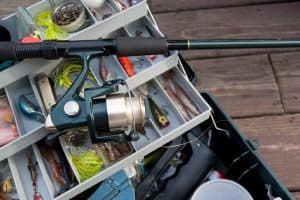
Like we said before, casting lures gives you the ability to cover large portions of the lake. They are the best option when you don’t know where trouts are.
Casting lures, like spoons, spinners, and crankbaits mimic small baitfish or other prey. Hence, they tend to work best when trouts are actively feeding. In other words, they work best during colder months.
Spoons and spinnerbaits are suitable for beginners as they are easier to use than crankbaits. Nevertheless, the latter has a more convincing look. You can also work them at various retrieve rates to see what works best, something that you can’t do with spinners and spoons.
Soft Plastic Lures for Trout
Affordability and versatility are the main advantages of soft plastic lures. They are widely available in different colors, sizes, and scents.
Soft plastic worms are a popular choice among trout anglers. They are as effective as natural worms but without the mess.
What Colors Do Trout Like?
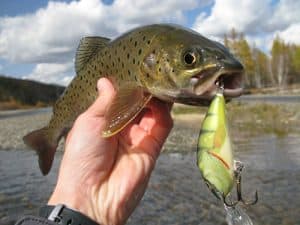
This is a common question among anglers. Some say that color does not matter, while others say it does. The reality is that while trouts might not like a specific color, it will be a lot easier for them to see the lure if it has the right one. So, it is a matter of presentation rather than of likes.
But, how to choose the best lure color for trout? Here you have some bits of advice:
- Match the color of the local prey: Although it might sound obvious, many anglers don’t do this. You will have more chances if your lure color is the same as the local baitfish.
- Water Clarity: The water is stained, or is it clear? Having this information at hand will greatly reduce color options.
Light colors work best on clear to mild-stained waters. Shades of blue, red, orange, metallic tones, and green will do the trick. The reason for this is that light easily penetrates clear waters. Hence, light colors will produce flashes that will attract trout.
In contrast, darker colors, such as black, dark green, and chartreuse, work like a charm on murky waters. Again, it is all about presentation.
Best Colors for Trout Fishing: A Summary
Yes, I know. We didn’t narrow the search down. But don’t worry. The section above was the theory. Here you have some of the best colors for trout fishing:
- Fluorescent Colors: They tend to work best on deep water as they aren’t washed away by the absence of light. In fact, fluorescent lures only need a little light to stand out.
- Yellow, Orange, and Red: Shades of yellow, red, and orange will trigger more bites on mild-stained waters. Some lures use them as a secondary color to increase the lure’s contrast.
- Metallic colors: Gold and silver are the prime choices. Both produce enough flashes to attract trouts even in murky waters.
One thing, though. Too many flashes might scare nearby trouts. That’s why some spoons come with a half-colored body.
- Brown and White: These natural-looking lures do a superb job imitating the local prey.
- Black: If there is not enough visibility, then a black-colored lure is what you need. Trouts will easily detect it as soon as the lure is on sight.
Trout Fishing Rods
You can choose between spinning, casting, and fly fishing rods. However, most anglers recommend using ultralight gear for trout fishing, and here, spinning rods are kings. Nevertheless, we will talk about all three.
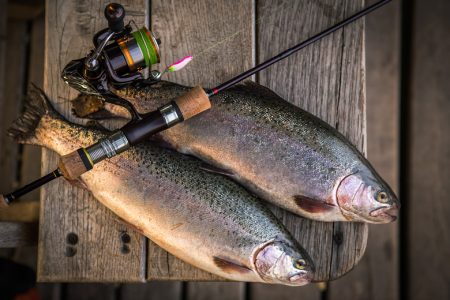
Length
The pole length determines how maneuverable the rod is and how far you can cast. Shorter poles are easier to control, while longer ones excel at casting.
For trout fishing, we recommend around 5 to 8 feet long casting or spinning rods. Ideally, you should go for a 7 feet long rod, as it is a good all-rounder.
Now, if fly fishing is your thing, then go for 7 1/2 to 8 feet long fly fishing rods.
Action
The action rating refers to where the rod bends and how easily it goes back to its natural state. There are three standard classes: Slow, moderate, and fast.
A slow action rod bends from the handle to the tip and takes the most time to get back to its unloaded state. In other words, it is not very responsive to bites and movement. As a result, they are not suitable for trout fishing.
Now, a moderate or medium-action rod bends around the upper half. Thus, they are more sensitive than slow action rods but stiffer than fast action poles. Most fly fishing rods for trout have this action rating.
Last but not least: Fast action poles. These are the most sensitive of all three and only bend in the tip. They are the quickest to get back. Therefore, you can feel even the slightest of nibbles, making them perfect for trout fishing purposes.
Nowadays, you can find rods that have extra-fast or moderate-fast action ratings. However, the same principle applies. An extra-fast rod is less stiff than a fast rod, and so on.
One thing that you should keep in mind that not all fast action rods are equally stiff. In other words, a KastKing fast action rod might not be as responsive as a fast action rod from St. Croix.
Power
Power refers to how strong the fishing rod is. In other words, it is the amount of pressure needed to bend the rod. Light, medium, and heavy are the three standard power ratings. However, some brands offer ultralight, medium-light, medium-heavy, and extra-heavy blanks.
As you might have guessed, a light rod is not as strong as a heavy one. Therefore, you need to apply less pressure to bend the first, but you will need much more for the second.
Power selection depends on the fish you are after. Heavier fish require more power. In this case, either an ultralight, light or medium-light rod will do the trick. Trouts aren’t known for having a massive weight. So, there is no point in having a thick pole.
Trout Fishing Reels
Getting a fishing reel is the next step once you have a fishing rod. Each rod type has a matching reel. For example, spinning reels are meant for spinning rods only.
Like rods, there are several features that you should consider before buying a fishing reel. Let’s take some time to talk about them.
Reel Size
Reel size determines how much fishing line you can wrap on it. Each reel comes with a number that shows the size. The bigger the number, the more lines the reel can hold.
Like we said before, trouts aren’t heavy fish. There is no point in buying a huge reel. So, stick between 1000 to 3000 sizes.
Make sure that the rod and the reel are compatible first. Thankfully, most fishing rods, if not all, come with a label that suggests which sizes work best.
Reel Drag
Drag is another feature that you must consider. It determines how much pressure the fish has to do to take the line out of the spool. Having a drag system of quality is crucial because you need it to tire the fish out.
You don’t need more than 15 pounds of drag for trout fishing. Again, trouts aren’t massive fishing. Thus, there is really no need for something more powerful.
Keep in mind that you should always set the drag below the line’s weight. A common rule of thumb is to set the drag around 1/3 of the line’s breaking point. For example, if you are using a 10-pound line, make sure to set around 3-pounds of drag.
Gear Ratio
Gear ratio refers to how many times the spool spins per handle crank. All reels come with an X:1 label, where X is the number of spool spins. Fast reels yield a quicker retrieve at the expense of less torque.
In contrast, slow ratios produce more torque but a slower retrieve. Now, for trout fishing, anything between 5 to 6:1 will work just fine. These ratios hit the sweet spot between speed and torque.
What Size Hooks for Trout Fishing?
Trouts are naturally wary of their surroundings. They will disappear in a blink of an eye if they ever see that something is off. Therefore, you must make sure that the hook doesn’t stand out too much in the water.
Sadly, the only way of doing this is by using small hooks. Besides, trouts don’t have a specially large mouth. Thus, they will avoid anything that won’t fit inside it.
So, to keep things short, stick between 8 to 14-sized hooks. Remember that the lower the number, the larger the hook is.
We encourage you to use barbless hooks if you are practicing catch and release. As the name suggests, these hooks have no barb. Hence, they do less damage to the fish you hook.
What Line for Trout Fishing?
The line is the last piece of gear to complete your trout fishing setup. In theory, you can choose between monofilament, fluorocarbon, braid, and hybrid fishing line. Let’s figure out which one is best.
Fluorocarbon
Fluorocarbon is nearly invisible once it hits the water. Thus, it is harder for fish to see it, including trouts. In addition, it has less line memory than monofilament fishing lines.
In terms of durability, fluorocarbon is also more durable than mono. However, it doesn’t handle abrasion as well as braid fishing lines. So far, fluorocarbon is looking like the best option. But there is a catch.
Fluorocarbon is denser than monofilament. Therefore, it sinks at a faster rate, making it not suitable for suspending rigs. In addition, it is way more expensive. That’s why many anglers use fluorocarbon as a leader instead of spooling the whole reel with it.
Monofilament
All anglers have used this line at one in their life. It is often the cheapest type of fishing line you can find. It stretches a lot, making things easier when tying a knot. However, it makes the line less sensible. You need to pay extra attention to movements because trouts aren’t known for their aggressive bites.
Another issue with stretch is that you are less likely to set the hook right. But not everything is bad news. Monofilament is not as visible as braid fishing lines. Plus, it is available in many colors that you can match with the water.
Braid
Braid is not the first line that comes into mind when thinking about trout fishing. It is highly visible, especially in clear waters, making it more likely for trouts to spot it.
However, braid fishing lines slimmer than comparable fluoro and mono lines. The advantage is that you can spool more of it into the spool. In addition, it doesn’t stretch at all. You will be able to feel even the slightest of movements, something that you do want when trout fishing.
Braid fishing lines are also the strongest ones in terms of abrasion. Thus, it is less likely to snap while fighting with the fish. While it has many advantages, the visibility factor is a huge deal breaker. I personally only use braid fishing lines with a fluoro or monofilament leader to conceal the main line.
Does the Line Color Matter for Trout Fishing?
While a certain color might not produce more bites than others, it surely makes a difference from a visibility point of view. Remember that trouts have a keen sense of sight. That’s what makes trout fishing so challenging. They will swim away the moment they notice something weird.
So, what is the best color for trout fishing? The best thing that you can do is go with a transparent fishing line like fluorocarbon. But if you only have monofilament spools, then try your best to match the line color to that of the water.
Try to get light blue or greenish fishing lines as most bodies of water have such coloration.
Make sure to check our trout fishing line guide for more information on the matter.
Trout Fishing: A Summary
Trout fishing is all about presentation. Choosing the right line, hook size, lure, and rig is crucial for a stealth approach. You will scare trouts away otherwise.
For this, we recommend using blue, transparent, or greenish fishing lines as they blend well in most waters. For rods, we suggest going for a light pole with fast or ultrafast action. Pair the rod with a 1000 to 3000 fishing reel, and you will be good to go.
Keep in mind that trouts love cold waters between 34 to 67 degrees Fahrenheit. If the water is hot, the chances are that trouts will be deeper in the water column. Now you have all you need to start. Happy fishing!

